In Python, the key to converting bytes to strings is to use the decode() method and specify the correct encoding format. 1. The most common method is to use UTF-8 encoding for decoding; 2. If you are not sure about the encoding method, you can try other common encodings such as 'latin1' or 'gbk'; 3. You can handle decoding errors by setting the errors parameter, such as ignore, replace or backslashreplace; 4. For special encoded data (such as base64), the corresponding decoding process must be performed first and then used the decode() method to convert to a string. Mastering these methods can deal with most of the conversion needs of bytes to strings.

In Python, converting bytes into strings is actually a very common operation, especially when dealing with network data, file reading, writing, or encoding conversion. The key is to figure out how the original bytes are encoded, the most common one is UTF-8.

Using the decode() method is the most direct way
Python's bytes type provides a decode() method that can convert byte data into strings. This method requires specifying the correct encoding format, otherwise an exception may be thrown or garbled.
data = b'Hello, world!' text = data.decode('utf-8') # Output: Hello, world!
If you are not sure how to encode, you can try several common encodings (such as 'latin1' or 'gbk'), but it is best to confirm the encoding standards from the source.

FAQ: If encoding parameters are skipped,
'utf-8'is used by default, but it may not apply in some cases, such as the text read on Windows may be'mbcs'or'gbk'encoding.
Handle possible decoding errors
Sometimes the bytes data you get is not "clean", such as containing some illegal characters or truncated content. At this time, you can control how to deal with these problems by setting the errors parameter:

-
errors='ignore': ignore the undecoded part -
errors='replace': replace the unrecognized part, usually using `` -
errors='backslashreplace': preserves the form of the original byte escaped with backslashes
For example:
bad_data = b'Hello\x80world' text = bad_data.decode('utf-8', errors='replace') # Output: Helloworld
This method is suitable for handling uncontrollable data sources, such as log files, content uploaded by users, etc.
If you know it's a special encoding, you can try other ways
Sometimes bytes may not be stored in regular text, such as base64-encoded strings:
import base64 encoded = base64.b64encode(b'Hello from Python!') decoded_bytes = base64.b64decode(encoded) text = decoded_bytes.decode('utf-8')
Similar situations include gzip compressed data, picture binary streams, etc. At this time, corresponding processing is required before decoding.
Basically that's it. By mastering decode() method, understanding the importance of encoding, and choosing the appropriate processing method according to the actual scenario, you can easily meet most of the conversion needs of bytes to strings.
The above is the detailed content of How to convert bytes to a string in Python. For more information, please follow other related articles on the PHP Chinese website!

Hot AI Tools

Undress AI Tool
Undress images for free

Undresser.AI Undress
AI-powered app for creating realistic nude photos

AI Clothes Remover
Online AI tool for removing clothes from photos.

Clothoff.io
AI clothes remover

Video Face Swap
Swap faces in any video effortlessly with our completely free AI face swap tool!

Hot Article

Hot Tools

Notepad++7.3.1
Easy-to-use and free code editor

SublimeText3 Chinese version
Chinese version, very easy to use

Zend Studio 13.0.1
Powerful PHP integrated development environment

Dreamweaver CS6
Visual web development tools

SublimeText3 Mac version
God-level code editing software (SublimeText3)
 How to handle API authentication in Python
Jul 13, 2025 am 02:22 AM
How to handle API authentication in Python
Jul 13, 2025 am 02:22 AM
The key to dealing with API authentication is to understand and use the authentication method correctly. 1. APIKey is the simplest authentication method, usually placed in the request header or URL parameters; 2. BasicAuth uses username and password for Base64 encoding transmission, which is suitable for internal systems; 3. OAuth2 needs to obtain the token first through client_id and client_secret, and then bring the BearerToken in the request header; 4. In order to deal with the token expiration, the token management class can be encapsulated and automatically refreshed the token; in short, selecting the appropriate method according to the document and safely storing the key information is the key.
 Explain Python assertions.
Jul 07, 2025 am 12:14 AM
Explain Python assertions.
Jul 07, 2025 am 12:14 AM
Assert is an assertion tool used in Python for debugging, and throws an AssertionError when the condition is not met. Its syntax is assert condition plus optional error information, which is suitable for internal logic verification such as parameter checking, status confirmation, etc., but cannot be used for security or user input checking, and should be used in conjunction with clear prompt information. It is only available for auxiliary debugging in the development stage rather than substituting exception handling.
 What are python iterators?
Jul 08, 2025 am 02:56 AM
What are python iterators?
Jul 08, 2025 am 02:56 AM
InPython,iteratorsareobjectsthatallowloopingthroughcollectionsbyimplementing__iter__()and__next__().1)Iteratorsworkviatheiteratorprotocol,using__iter__()toreturntheiteratorand__next__()toretrievethenextitemuntilStopIterationisraised.2)Aniterable(like
 What are Python type hints?
Jul 07, 2025 am 02:55 AM
What are Python type hints?
Jul 07, 2025 am 02:55 AM
TypehintsinPythonsolvetheproblemofambiguityandpotentialbugsindynamicallytypedcodebyallowingdeveloperstospecifyexpectedtypes.Theyenhancereadability,enableearlybugdetection,andimprovetoolingsupport.Typehintsareaddedusingacolon(:)forvariablesandparamete
 How to iterate over two lists at once Python
Jul 09, 2025 am 01:13 AM
How to iterate over two lists at once Python
Jul 09, 2025 am 01:13 AM
A common method to traverse two lists simultaneously in Python is to use the zip() function, which will pair multiple lists in order and be the shortest; if the list length is inconsistent, you can use itertools.zip_longest() to be the longest and fill in the missing values; combined with enumerate(), you can get the index at the same time. 1.zip() is concise and practical, suitable for paired data iteration; 2.zip_longest() can fill in the default value when dealing with inconsistent lengths; 3.enumerate(zip()) can obtain indexes during traversal, meeting the needs of a variety of complex scenarios.
 Python FastAPI tutorial
Jul 12, 2025 am 02:42 AM
Python FastAPI tutorial
Jul 12, 2025 am 02:42 AM
To create modern and efficient APIs using Python, FastAPI is recommended; it is based on standard Python type prompts and can automatically generate documents, with excellent performance. After installing FastAPI and ASGI server uvicorn, you can write interface code. By defining routes, writing processing functions, and returning data, APIs can be quickly built. FastAPI supports a variety of HTTP methods and provides automatically generated SwaggerUI and ReDoc documentation systems. URL parameters can be captured through path definition, while query parameters can be implemented by setting default values ??for function parameters. The rational use of Pydantic models can help improve development efficiency and accuracy.
 How to test an API with Python
Jul 12, 2025 am 02:47 AM
How to test an API with Python
Jul 12, 2025 am 02:47 AM
To test the API, you need to use Python's Requests library. The steps are to install the library, send requests, verify responses, set timeouts and retry. First, install the library through pipinstallrequests; then use requests.get() or requests.post() and other methods to send GET or POST requests; then check response.status_code and response.json() to ensure that the return result is in compliance with expectations; finally, add timeout parameters to set the timeout time, and combine the retrying library to achieve automatic retry to enhance stability.
 Setting Up and Using Python Virtual Environments
Jul 06, 2025 am 02:56 AM
Setting Up and Using Python Virtual Environments
Jul 06, 2025 am 02:56 AM
A virtual environment can isolate the dependencies of different projects. Created using Python's own venv module, the command is python-mvenvenv; activation method: Windows uses env\Scripts\activate, macOS/Linux uses sourceenv/bin/activate; installation package uses pipinstall, use pipfreeze>requirements.txt to generate requirements files, and use pipinstall-rrequirements.txt to restore the environment; precautions include not submitting to Git, reactivate each time the new terminal is opened, and automatic identification and switching can be used by IDE.






